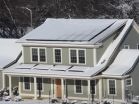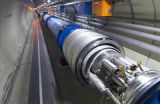(Press-News.org) The net-zero energy test house at the National Institute of Standards and Technology (NIST) in suburban Washington, D.C., not only absorbed winter's best shot, it came out on top, reaching its one-year anniversary on July 1 with enough surplus energy to power an electric car for about 1,440 miles.*
Watch the YouTube video at https://www.youtube.com/watch?v=iJZrOhPk4kg
Despite five months of below-average temperatures and twice the normal amount of snowfall, NIST's Net-Zero Energy Residential Test Facility (NZERTF) ended its one-year test run with 491 kilowatt hours of extra energy. Instead of paying almost $4,400 for electricity—the estimated average annual bill for a comparable modern home in Maryland—the virtual family of four residing in the all-electric test house actually earned a credit by exporting the surplus energy to the local utility.
"We made it—and by a convincing margin," said Hunter Fanney, the mechanical engineer who leads NZERTF-based research. "From here on in, our job will be to develop tests and measurements that will help to improve the energy efficiency of the nation's housing stock and support the development and adoption of cost-effective, net-zero energy designs and technologies, construction methods and building codes."
A net-zero energy house produces at least as much energy as it consumes over the course of a year. A number of states are taking steps toward encouraging or even requiring construction of net-zero energy homes in the future. For example, California will require that, as of 2020, all newly constructed homes must be net-zero energy ready.
Both a laboratory and a house, the two-story, four-bedroom, three-bath NZERTF would blend in nicely in a new suburban subdivision. But it was designed and built to be about 60 percent more energy efficient than houses built to meet the requirements of the 2012 version of the International Energy Conservation Code, which Maryland has adopted.
The 2,700 square-foot (252-square-meter) test house is built to U.S. Green Building Council LEED Platinum standards—the highest standard for sustainable structures. Its features include energy-efficient construction and appliances, as well as energy-generating technologies, such as solar water heating and a solar photovoltaic system.
Despite 38 days when the test house's solar panels were covered with snow or ice, the NZERTF's sun-powered generation system produced 13,577 kilowatt hours of energy. That's 491 kilowatt hours more than used by the house and its occupants, a computer-simulated family of two working parents and two children, ages 8 and 14.
First year energy use totaled 13,086 kilowatt hours, which was about 3,000 kilowatt hours more than projected usage in a year with typical weather. In a normal year, a comparable home built to meet Maryland's residential energy standard would consume almost 27,000 kilowatt hours of energy.
In terms of energy consumed per unit of living space—a measure of energy-use intensity—the NIST test house is calculated to be almost 70 percent more efficient than the average house in Washington, D.C., and nearby states.
From July through October, the facility registered monthly surpluses. In November, when space-heating demands increased and the declining angle of the sun reduced the energy output of its 32 solar panels, the NZERTF began running monthly deficits. Through March 31, when the house's net energy deficit plummeted to 1,800 kilowatt hours—roughly equivalent to the combined amount of energy a refrigerator and clothes dryer would use in a year—temperatures consistently averaged below normal.
Starting in April, the energy tide began to turn as the house began to export electric power to the grid on most days.
"The most important difference between this home and a Maryland code-compliant home is the improvement in the thermal envelope—the insulation and air barrier," says NIST mechanical engineer Mark Davis. By nearly eliminating the unintended air infiltration and doubling the insulation level in the walls and roof, the heating and cooling load was decreased dramatically.
In terms of cost, the NZERTF's virtual residents saved $4,373 in electricity payments, or $364 a month. However, front-end costs for solar panels, added insulation, triple-paned windows, and other technologies and upgrades aimed at achieving net-zero energy performance are sizable, according to an analysis by NIST economist Joshua Kneifel.
In all, Kneifel estimates that incorporating all of the NZERTF's energy-related technologies and efficiency-enhancing construction improvements would add about $162,700 to the price of a similar house built to comply with Maryland's state building code.
Planned measurement-related research at the NZERTF will yield knowledge and tools to help trim this cost difference. Results also will be helpful in identifying affordable measures that will be most effective in reducing energy consumption. And research will further the development of tests and standards that are reliable benchmarks of energy efficiency and environmental performance overall, providing information useful to builders, home buyers, regulators and others.
INFORMATION:
*An electric car gets 2.94 miles per kilowatt hour, according to the Environmental Protection Agency (2012).
NIST test house exceeds goal; ends year with energy to spare
2014-07-01
ELSE PRESS RELEASES FROM THIS DATE:
Biomarker predicts effectiveness of brain cancer treatment
2014-07-01
Researchers at the University of California, San Diego School of Medicine have identified a new biomarker that predicts whether glioblastoma – the most common form of primary brain cancer – will respond to chemotherapy. The findings are published in the July print issue of Oncotarget.
"Every patient diagnosed with glioblastoma is treated with a chemotherapy called temozolomide. About 15 percent of these patients derive long-lasting benefit," said Clark C. Chen, MD, PhD, vice-chairman of Academic Affairs, Division of Neurosurgery, UC San Diego School of Medicine and the ...
Plants respond to leaf vibrations caused by insects' chewing, MU study finds
2014-07-01
VIDEO:
Experiments by Heidi Appel and Rex Cocroft at the University of Missouri mark the first time scientists have shown that a plant responds to an ecologically relevant sound in its...
Click here for more information.
COLUMBIA, Mo. – Previous studies have suggested that plant growth can be influenced by sound and that plants respond to wind and touch. Now, researchers at the University of Missouri, in a collaboration that brings together audio and chemical analysis, have ...
Reigning in chaos in particle colliders yields big results
2014-07-01
WASHINGTON D.C., June 30, 2014 – When beams with trillions of particles go zipping around at near light speed, there's bound to be some chaos. Limiting that chaos in particle colliders is crucial for the groundbreaking results such experiments are designed to deliver.
In a special focus issue of the journal Chaos, from AIP Publishing, a physicist at the European Organization for Nuclear Research (CERN) details an important method of detecting and correcting unwanted chaotic behavior in particle colliders. The method is helping accelerator physicists design high-performing, ...
Research reveals a gender gap in the nation's biology labs
2014-07-01
CAMBRIDGE, MA -- Among the sciences, biology consistently attracts the greatest numbers of women to graduate school and academic careers. About half of all biology graduate students are women, and 40 percent of biology postdocs are female. However, those numbers drop dramatically among faculty members: Nationwide, only 36 percent of assistant professors and 18 percent of full professors are women.
A new study reveals a possible explanation for this discrepancy: In the labs of the highest-achieving male biology professors — winners of the Nobel Prize, the National Medal ...
Study reveals that many people are oblivious to how they come across to counterparts and colleagues
2014-07-01
NEW YORK—Jill Abramson was recently ousted from her position as the executive editor of The New York Times for being, among other things, too "pushy." But did Abramson—who has also been described by the media as "polarizing" and "brusque"—know during the course of her tenure that others viewed her as being overly assertive? A new study from the Columbia Business School suggests that there's a great chance she didn't.
"Finding the middle ground between being pushy and being a pushover is a basic challenge in social life and the workplace. We've now found that the challenge ...
All the world's oceans have plastic debris on their surface
2014-07-01
However, central surface waters of the oceans may not be the final destination of plastic debris since, as indicated by the study performed by the Malaspina Expedition, large amounts of microplastics could be passing to the marine food chain and the ocean floor. Results of the study, led by the University of Cadiz (Spain), have been published in the journal Proceedings of the National Academy of Sciences (PNAS).
Andrés Cózar, researcher from the University of Cadiz, explains: "Ocean currents carry plastic objects which split into smaller and smaller fragments due to solar ...
Genetic evidence that body mass increases the risk of asthma in mid-childhood
2014-07-01
Some of the increase in asthma risk toward the end of the 20th century could be attributed to the increase in body mass index (BMI) in mid-childhood, according to new research published in this week's PLOS Medicine. The study, led by Raquel Granell from the University of Bristol, UK, and colleagues, provides genetic evidence that higher fat mass and lean mass increase the risk of asthma in mid-childhood.
The incidence of asthma, a chronic condition caused by inflammation of the airways, has been rising steadily over the past few decades, and it is estimated that 200� ...
Cesarean section linked to slight increase in future stillbirth and ectopic pregnancy
2014-07-01
Caesarean section is associated with a slightly increased rate of subsequent stillbirth and ectopic pregnancy, according to a large study of women living in Demark, published in this week in PLOS Medicine. Given the global increase in Caesarean rates, the results of the study, which was conducted by Louise Kenny and colleagues from University College Cork, Ireland and Aarhus University, Denmark, are of interest to pregnant women, their partners, and healthcare providers.
The researchers obtained data for 832,996 women from Danish national registers regarding their first ...
Catheter ablation a first-line treatment for atrial flutter
2014-07-01
Use of catheter ablation is not only beneficial for treating atrial flutter but also can significantly reduce hospital visits – both inpatient and emergency – and lower the risk for atrial fibrillation, according to research by UC San Francisco.
The study is in the July issue of PLOS ONE and available online.
"We've seen firsthand in our clinical experience that atrial flutter is difficult to control with drugs, even more than atrial fibrillation," said senior author Gregory Marcus, MD, director of clinical research in the UCSF Division of Cardiology. "Based on our ...
New insights from the modENCODE Project are published in Genome Research
2014-07-01
July 1, 2014 – Genome Research publishes six articles online and in print today describing recent advancements from the modENCODE Project. Initially launched in 2007, the goal of the modENCODE Project is to comprehensively characterize functional genomic elements in two model organisms, the fly Drosophila melanogaster, and the worm Caenorhabditis elegans. Comparative analyses in these well-established systems are expected to guide efforts to further our understanding of human biology. The articles published in this issue present new genomic advances shedding light upon ...




